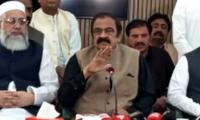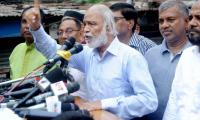The writer is former executive editor of The News and a senior journalist with Geo TV.
Most of us spent this Eid divorced from any notion about the plight of those displaced from their homes in the Federally Administered Tribal Areas. The usual focus, inspired by transitory sympathy whose exhibition is customary on all such occasions, was missing. More news was broadcast of how Karachi’s politics was hanging by the skins of the sacrificed goats than about the grinding misery of Fata’s residents.
This shameful spell of apathy was partly shaken by terrorism in the Mohmand Agency last Friday – which claimed over a dozen lives – but then it was all about a spectacular event, blood-splattered bodies and howls of condemnation.
The citizen, who has been chucked out of his abode by the force of multiple operations in Fata, has remained a zoomed out object. He, she and the child are not even a dot on the conscience of the nation. Why is that?
The multi-layered answer is simple to understand. The first layer of the answer relates to our tendency to oversimplify complex challenges because we have no stomach for the truth. Fata’s displaced people and the dreadfulness of their out-of-home experience does not fit into the glorious tale of victory that we want to tell at every forum.
We have produced a narrative of total success about Operation Zarb-e-Azb and have projected its positive consequences so overwhelmingly that any strand of information or evidence of its blowback for the population has no space in our orientation.
Displaced persons were a handy topic when we needed to galvanise the nation’s support for the cause of fighting terrorists in North Waziristan. They served the useful purpose of painting a picture of a nation willing to sacrifice anything to beat the deadly menace at its doorstep. Streams of families covering long distances and settling in unsettling conditions made a superb plot to weave a sympathetic chord that could produce lasting sympathy – and, of course, garner resources.
Yes, resources. Wars are not fought without money, and money is hard to obtain in a country where competing demands are such that the national pie gets cut and divided up in a million slices on its own. By using the imagery of the misery of displaced populations, funds could be obtained. No government can afford to come across as callous towards those chunks of the population that are suffering for a national cause.
So, for a while, the Internally Displaced People of Fata were right up there in the slot of top issues because they greased the wheels of the system and enthused everybody with goosebumps-raising pictures of national resolve.
However, since that need (of resource claim and zooming in of national energies on North Waziristan) has been replaced by the other need of insisting that the counterterrorism plan has been super successful, we now don’t want to talk about how the IDPs are living and what woes blight their pitiable lives when they go back to ruined homes and destroyed fields. It is not as is if there is not enough material for debating the truth about the challenges facing the IDPs.
A couple of valuable reports have come out in the past few days that detail with a lot of data the situation the IDPs are in. There is plenty of information available on out-of-school children, on anaemic mothers, on families pushed into hellish poverty because their economic life support has been uprooted. It is easy to find people’s testimonies in which they narrate their side of the story of displacement, of the nagging fear of being obliterated socially, economically and in some cases even physically because vestiges of local Taliban groups continue to operate and threaten to visit horrible revenge upon them.
But we conveniently factor out these dimensions from our framework of reference to Fata’s people because we don’t want to debate. Period. Debate is hazardous. It takes us in directions we don’t want to go to. It kills propaganda and reduces the grandiosity and grandstanding of military operations to facts that are unpleasant. Unaccomplishment is closely tied to the unfulfilment of the needs of Fata’s residents.
Failure sits next to the wretchedness of a daily life that offers no hope in the immediate future to thousands of families. We don’t want to go there. We have to pretend that we have achieved everything. We have to fake total success. We are intent on saying that Shawal is now Switzerland and Tirah is the south of France. Anything short of such absurd claims would not complete the Orwellian cycle of misinformation that now defines our outlook on Fata.
Driving us further away from the reality of Fata’s inhabitants is a media that wakes up in the morning signing songs of praise of ‘mission accomplished’ and rests at night dreaming of starting another day the same way. And the mainstream media’s abdication of professional responsibility towards the reality in Fata would not have been so total if there was not such a total control of information flow from that area.
Reporting out of Fata is now akin to reporting from a permanent war zone even though we continue to say that the terrorists have all been sent to eternal damnation. Access is tightly controlled. Visits are not possible without No Objection Certificates. Friendly media groups are invited to do the dog and pony show and those asking critical questions are avoided like the plague.
Everything is uni-dimensional about Fata: great things have happened here and only great things can be reported from here. Anything else is travesty of the official truth. It is waved off in a single and oft-heard phrase ‘doubts are being created about success of Fata operations’. That’s the end of it.
Resultantly, even a slim chance of a more realistic, holistic and people-centric view of Fata that could have emerged on account of independent reporting has not arisen. This contrasts sharply with how reporting was done previously on this part of Pakistan. Among dozens of operations (and after them) access was granted to journalists to ascertain facts and also bring back packs of perspectives that are generally not available through deodorised official versions.
None of the areas that had seen intense military operations was shut down for independent scrutiny. This allowed real voices to be heard without being modified to sound like a hymn of praise and salutation. That in turn allowed policy adjustment and, most important, pushed closed doors to open up to accommodate people’s demands. Not anymore. There is a virtual information blackout on Fata. It is a no-go area for the inquirer. The nation knows nothing about what has happened to their brothers and sisters in Fata – how they were suffering when we were dancing in pop concerts of paid patriotism.
It is unlikely that this span of inattention and distortion of reality about Fata will change. We have invested so much energy, resources and effort into building a wall of heroism between ourselves and the reality in Fata that seeing across is not possible any more. So for all practical purposes we will insist that Fata is a land of milk and honey where children grow and women glow, where men have peace and bread is aplenty, where disease is non-existent and happiness and health is the low hanging fruit available to everyone.
We will live in denial about Fata while those living in Fata will live, for a long time to come, like les miserables, godless and forsaken.
Email: syedtalathussain@gmail.com
Twitter: @TalatHussain12
This demand has fueled rapid growth deposit base of Islamic Banks and Islamic Windows operated by conventional banks
But Punjab Agriculture Food and Drug Authority building near Thokar Niazbeg on Multan Road stands out
Macron has been particularly vocal in their criticism, asserting that withholding arms from Kyiv plays directly into...
As PPP governs province, Bilawal Bhutto Zardari holds strategic position to address both violence and its underlying...
Critics argue that strategy is vague, but closer look indicates strategic alignment with global trends and national...
To defeat it, we must distrust bot-driven narratives, to defeat it, we must verify sources before believing or sharing







